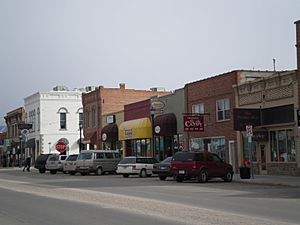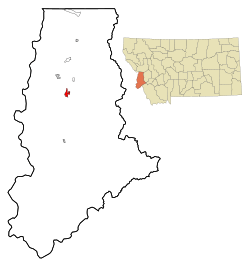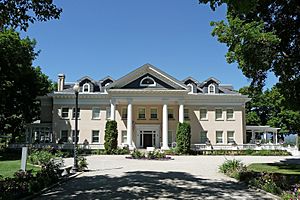Hamilton, Montana facts for kids
Quick facts for kids
Hamilton
|
|
|---|---|

Downtown Hamilton
|
|

Location of Hamilton, Montana
|
|
| Country | United States |
| State | Montana |
| County | Ravalli |
| Area | |
| • Total | 2.60 sq mi (6.73 km2) |
| • Land | 2.54 sq mi (6.58 km2) |
| • Water | 0.06 sq mi (0.15 km2) |
| Elevation | 3,570 ft (1,090 m) |
| Population
(2020)
|
|
| • Total | 4,659 |
| • Density | 1,832.81/sq mi (707.68/km2) |
| Time zone | UTC−7 (Mountain (MST)) |
| • Summer (DST) | UTC−6 (MDT) |
| ZIP code |
59840
|
| Area code(s) | 406 |
| FIPS code | 30-33775 |
| GNIS feature ID | 0784496 |
| Website | www.cityofhamilton.net |
Hamilton is a city that serves as the county seat of Ravalli County, Montana, United States. The population was 4,659 at the 2020 census.
Contents
History
Hamilton was founded by copper king Marcus Daly in the late 19th century. It was named for J.W. Hamilton, who provided the right-of-way to the railroad. Daly is said to have wanted to begin business in the then county seat of Grantsdale, but was denied the opportunity. He supposedly founded Hamilton out of his own pocket as a reaction to being rebuffed at Grantsdale.
In the summer of 2000, Hamilton made international headlines when forest fires throughout the Bitterroot Valley filled the area with smoke and prompted the evacuation of many residents. President Clinton declared a state of emergency in the area and dispatched National Guard troops to assist with fighting the fires.
Geography and climate
Hamilton is located at 46°14′54″N 114°9′35″W / 46.24833°N 114.15972°W (46.248412, -114.159852).
According to the United States Census Bureau, the city has a total area of 2.57 square miles (6.66 km2), of which 2.53 square miles (6.55 km2) is land and 0.04 square miles (0.10 km2) is water.
According to the Köppen climate classification, Hamilton has a humid continental climate.
| Climate data for Hamilton, Montana (1981–2010) | |||||||||||||
|---|---|---|---|---|---|---|---|---|---|---|---|---|---|
| Month | Jan | Feb | Mar | Apr | May | Jun | Jul | Aug | Sep | Oct | Nov | Dec | Year |
| Mean daily maximum °F (°C) | 36.7 (2.6) |
41.8 (5.4) |
51.4 (10.8) |
59.1 (15.1) |
67.6 (19.8) |
75.2 (24.0) |
85.1 (29.5) |
83.7 (28.7) |
72.8 (22.7) |
59.3 (15.2) |
44.2 (6.8) |
34.0 (1.1) |
59.2 (15.1) |
| Mean daily minimum °F (°C) | 18.8 (−7.3) |
20.7 (−6.3) |
26.9 (−2.8) |
32.7 (0.4) |
39.5 (4.2) |
45.6 (7.6) |
50.2 (10.1) |
48.6 (9.2) |
40.8 (4.9) |
31.8 (−0.1) |
24.3 (−4.3) |
16.8 (−8.4) |
33.1 (0.6) |
| Average precipitation inches (mm) | 0.88 (22) |
0.86 (22) |
0.97 (25) |
0.99 (25) |
1.67 (42) |
1.61 (41) |
0.99 (25) |
1.06 (27) |
1.01 (26) |
0.76 (19) |
1.19 (30) |
1.17 (30) |
13.17 (335) |
| Average snowfall inches (cm) | 3.0 (7.6) |
3.2 (8.1) |
1.5 (3.8) |
0.3 (0.76) |
0.2 (0.51) |
0.0 (0.0) |
0.0 (0.0) |
0.0 (0.0) |
0.0 (0.0) |
0.1 (0.25) |
2.3 (5.8) |
3.5 (8.9) |
14.3 (36) |
| Source: NOAA | |||||||||||||
Demographics
| Historical population | |||
|---|---|---|---|
| Census | Pop. | %± | |
| 1880 | 50 | — | |
| 1900 | 1,257 | — | |
| 1910 | 2,240 | 78.2% | |
| 1920 | 1,700 | −24.1% | |
| 1930 | 1,839 | 8.2% | |
| 1940 | 2,332 | 26.8% | |
| 1950 | 2,678 | 14.8% | |
| 1960 | 2,475 | −7.6% | |
| 1970 | 2,499 | 1.0% | |
| 1980 | 2,661 | 6.5% | |
| 1990 | 2,737 | 2.9% | |
| 2000 | 3,705 | 35.4% | |
| 2010 | 4,348 | 17.4% | |
| 2020 | 4,659 | 7.2% | |
| U.S. Decennial Census | |||
2010 census
As of the census of 2010, there were 4,348 people, 2,175 households, and 1,006 families living in the city. The population density was 1,718.6 inhabitants per square mile (663.6/km2). There were 2,456 housing units at an average density of 970.8 per square mile (374.8/km2). The racial makeup of the city was 95.0% White, 0.3% African American, 0.6% Native American, 1.4% Asian, 0.2% from other races, and 2.5% from two or more races. Hispanic or Latino of any race were 3.1% of the population.
There were 2,175 households, of which 23.6% had children under the age of 18 living with them, 30.6% were married couples living together, 11.7% had a female householder with no husband present, 3.9% had a male householder with no wife present, and 53.7% were non-families. 47.0% of all households were made up of individuals, and 22.8% had someone living alone who was 65 years of age or older. The average household size was 1.92 and the average family size was 2.72.
The median age in the city was 43 years. 20.1% of residents were under the age of 18; 7.4% were between the ages of 18 and 24; 24.4% were from 25 to 44; 23.4% were from 45 to 64; and 24.7% were 65 years of age or older. The gender makeup of the city was 46.6% male and 53.4% female.
Economy
Hamilton is, as of 2004, home to two microbiological research and production facilities: the government-run Rocky Mountain Laboratories, and a branch of the Corixa Corporation (bought in the late 1990s from Ribi ImmunoChem Research, Inc.). The Corixa Corporation was bought by GlaxoSmithKline in 2005. NIAID (National Institute of Allergy and Infectious Diseases) completed construction of a Biosafety Level 4 biohazard laboratory as part of the Rocky Mountain Laboratories (RML) facility in 2008. This facility has begun operations using highly-pathogenic organisms including the Lentivirus family of viruses.
Hamilton had one of the last remaining Kmart stores in the United States, which was the only remaining one in the state of Montana and the entire Mountain time zone. However, plans to close the Kmart store were announced in January 2022, with its final day of business conducted on March 6, 2022.
Arts and culture
The Ravalli County Museum, founded in 1955, is located in the former Ravalli County Courthouse and focuses on county history, natural history and art. The Daly Mansion, home of Marcus Daly, offers tours. This luxurious mansion has over 50 rooms, 26 acres of lawns, and several outbuildings.
Being located in the dramatically scenic Bitterroot Valley Hamilton is a great place for outdoor activity. Nature hikes and wildlife viewing opportunities are boundless. River Park and Skalkaho Bend offer trails in town.
A large skatepark, Circle 13, is at Claudia Driscoll Park. It is one of the skateparks built by Montana Pool Service, a project founded by Jeff Ament.
The 700-seat Hamilton Performing Arts Center at Hamilton High School is home for the annual Bitterroot Performing Arts Series, produced by the Bitterroot Performing Arts Council, as well as other school and public productions throughout the year.
Infrastructure
Hamilton is located directly on U.S. Route 93. It is intersected by Montana Secondary Highway 269.
Ravalli County Airport is a public use airport 1 mile east of town.
Daly Hospital, part of Bitterroot Health, provides healthcare service in Hamilton.
Education
- Hamilton High School
- The Bitterroot College Program of the University of Montana is located in Hamilton. In May 2012, it was renamed Bitterroot College University of Montana.
The Bitterroot Public Library serves the town of Hamilton. It was one of the 17 Carnegie libraries built in Montana.
Media
Hamilton's newspaper is the Ravalli Republic. It is a daily broadsheet offered as print or e-edition as well as having online news.
Five radio stations are licensed in Hamilton: KBAZ with mainstream rock, KHKM with adult hits, KLYQ is news/talk, KMZO is a religious channel, and KUFN public radio.
Notable people
- Willy Burgdorfer, scientist who discovered the cause of Lyme disease
- Herald Rea Cox, bacteriologist
- Marcus Daly, one of the "Copper Kings" of Butte, Montana, owned the Bitterroot Stock Farm near Hamilton
- Henry L. Myers, United States Senator from Montana
- Jerry J. O'Connell, United States Representative from Montana, editor and publisher of local newspaper
- Val Skinner, golfer, winner of six LPGA Tour events
- Suzanna Son, film actress known for Red Rocket
- Michael D. Stevens, former Master Chief Petty Officer of the Navy
See also
 In Spanish: Hamilton (Montana) para niños
In Spanish: Hamilton (Montana) para niños


